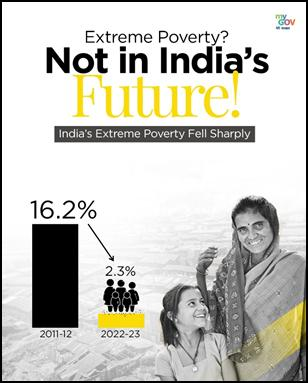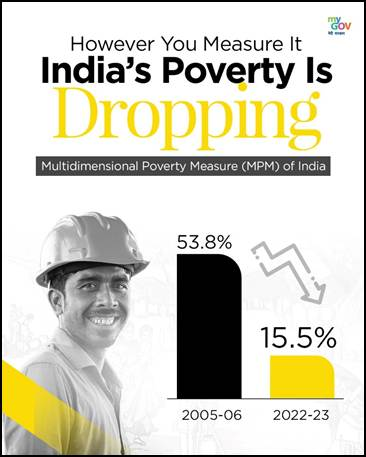Social Issues
World Bank’s Poverty & Equity Brief Report
- 30 Apr 2025
- 13 min read
For Prelims: World Bank, Multidimensional Poverty Index (MPI), World Economic Forum’s Global Gender Gap Report, Pradhan Mantri Ujjwala Yojana, Public Distribution System (PDS), PM Surya Ghar: Muft Bijli Yojana
For Mains: Poverty in India: Associated Social Issues Related to Poverty and Way Forward
Why in News?
The World Bank’s Spring 2025 Poverty and Equity Brief report praised India for lifting 171 million people out of extreme poverty from 2011-12 to 2022-23, lowering the extreme poverty rate from 16.2% to 2.3%.
- This highlights India’s dedication to inclusive development through welfare schemes, and improved access to essential services.
What are Poverty and Equity Briefs (PEBs)?
- About: The PEBs, published biannually during the Spring and Annual Meetings of the World Bank Group and International Monetary Fund (IMF).
- It provides insights into poverty, shared prosperity, and inequality trends for over 100 developing countries.
- Key Development Indicators: Cover various aspects of poverty, using both national poverty lines and international benchmarks (USD 2.15 for extreme poverty, USD 3.65 for lower-middle-income, and USD 6.85 for upper-middle-income).
- A multidimensional poverty measure that accounts for non-monetary deprivations like education and basic services, and inequality measurements using the Gini Index.
- Methodology for India: The World Bank’s poverty estimates for India are based on the 2011–12 Consumption Expenditure Survey (CES) and the 2022–23 Household Consumption Expenditure Survey.
What are the Key Highlights of the Poverty and Equity Briefs Report by the World Bank?
- Rural and Urban Poverty Reduction: Extreme poverty in India fell significantly, from 18.4% to 2.8% in rural areas and from 10.7% to 1.1% in urban areas between 2011-12 and 2022-23.
- Statewise Contribution: In 2011-12, the five most populous states- Uttar Pradesh, Maharashtra, Bihar, West Bengal, and Madhya Pradesh accounted for 65% of India’s extreme poor. By 2022-23, these states contributed to two-thirds of the overall decline in extreme poverty.
- Decline in Multidimensional Poverty: The report highlighted a decline in non-monetary poverty, with India’s Multidimensional Poverty Index (MPI) dropping from 53.8% in 2005-06 to 16.4% in 2019-21.
- By 2022-23, the World Bank’s Multidimensional Poverty Measure stood at 15.5%, indicating continued improvements in living conditions.
- India’s consumption-based Gini index improved from 28.8 in 2011-12 to 25.5 in 2022-23, indicating a reduction in income inequality.
- Employment Growth and Workforce Trends: Employment rates, especially for women, are rising, and urban unemployment is at its lowest since 2017-18. However, only 23% of non-farm paid jobs are formal.
- Despite 31% female employment, there are still significant gender gaps, with 234 million more men in paid work.
- Progress at Lower-Middle-Income Level: At the USD 3.65 per day poverty line, India’s poverty rate dropped from 61.8% to 28.1%, lifting 378 million people out of poverty.
- This reflects that the benefits of economic growth have reached the lower-middle-income groups in both rural and urban areas.
Note: The Gini index determines a nation's level of income inequality by measuring the income distribution or wealth distribution across its population.
- Generally, developed countries tend to have lower Gini coefficients (e.g., below 0.30), indicating relatively lower income or wealth inequality.
What are the Associated Social Issues Related to Poverty?
- Marginalization of Vulnerable Communities: Poverty deepens the marginalization of SCs and STs by limiting their access to education, healthcare, and employment. Discrimination in education, poor health outcomes, and restricted job opportunities in low-wage sectors further entrench their socio-economic exclusion.
- Health Disparities and Malnutrition: Health issues are widespread in poverty-stricken areas, where inadequate access to nutritious food and healthcare exacerbates health outcomes.
- Government initiatives like the National Nutrition Mission (POSHAN Abhiyaan) aim to combat malnutrition, however, challenges persist in ensuring effective implementation and reaching the most deprived populations.
- Water Stress and Scarcity: Communities in poverty, particularly in rural areas, are disproportionately affected, with limited access to clean drinking water, leading to waterborne diseases and poor sanitation.
- The NFHS-5 reports that 49.8% of rural households still lack access to piped drinking water.
- Energy Poverty: In rural India, particularly in tribal and backward regions, lack of access to affordable energy limits educational and economic opportunities.
- Despite efforts like the Pradhan Mantri Ujjwala Yojana, data deficiency in the SECC 2011 has excluded many deserving households, hindering the shift from firewood to LPG.
- Mental Poverty: Poverty causes chronic stress, anxiety, and depression due to financial insecurity and social marginalization, reducing productivity and social participation.
- The stigma around poverty discourages help-seeking, while unemployment (affecting 29% of graduates) and rising inequality, worsen mental health challenges.
- Gender Disparity: Gender disparities in impoverished communities, such as early marriage, domestic violence, and limited workforce participation, perpetuate the poverty cycle.
- A World Bank report reveals that there are 234 million more men than women in paid employment, with the female employment rate at just 31%.
- According to the World Economic Forum’s Global Gender Gap Report 2024, India ranked 129th, highlighting significant disparities in economic participation and opportunities for women, leading to the underutilization of women's potential in the workforce.
- Environmental Degradation; Poverty drives reliance on unsustainable practices like deforestation, overgrazing, and burning biomass for fuel, leading to environmental degradation.
- This worsens poverty by reducing agricultural productivity and increasing vulnerability to climate change. Poor communities are disproportionately impacted by pollution and natural disasters.
What Measures Can Be Taken to Address the Social Issues Linked to Poverty?
- Social Welfare and Economic Empowerment: Strengthening affirmative action and welfare schemes is key to improving access to healthcare, education, and employment for marginalized communities.
- Bridging the Gender Gap: It is essential to strengthen initiatives like Beti Bachao Beti Padhao and Sukanya Samriddhi Yojana (SSY). Further efforts should focus on expanding women’s access to education, healthcare, and financial independence, while also ensuring effective implementation of these programs.
- Bridging the gender gap requires ensuring equal pay, expanding skill development, and creating gender-inclusive workplaces while addressing poverty to enhance women’s economic opportunities.
- Improving Energy Access: Promoting solar-powered 4G cell towers and solar microgrids in remote areas will improve energy access, create opportunities for education and facilitate information sharing.
- Scaling up initiatives like the PM Surya Ghar: Muft Bijli Yojana will help provide solar-powered solutions to off-grid communities.
- Universal Water Access: Large-scale water conservation programs like rainwater harvesting, watershed management, and groundwater recharge should be prioritized.
- The Jal Jeevan Mission, which aims to provide piped drinking water to every rural household, is a crucial step in improving water access and sustainability.
- Enhancing Mental Health Support: There is a need to scale up the National Mental Health Programme to offer counseling and support in both rural and urban poor communities.
- Train community health workers, such as ASHA workers, to identify and address mental health issues at the grassroots level.
- Launch awareness campaigns to reduce the stigma around mental health and encourage help-seeking behavior.
- Ensuring Transparency & Accountability: To address fake beneficiaries in welfare schemes, Aadhaar-based authentication and eKYC verification are essential to remove fake ration cards.
Conclusion:
Tackling poverty in India demands comprehensive solutions that address the underlying issues of inequality, access to resources, and inefficient policy implementation. By strengthening welfare schemes, enhancing infrastructure, and empowering marginalized communities, India can make significant progress in reducing poverty. Through sustained efforts and collaborative action, a more inclusive and prosperous future is achievable for all.
| Drishti Mains Question: Q. Critically examine the impact of government welfare schemes on poverty alleviation and suggest effective measures to address the social issues linked to poverty in India. |
UPSC Civil Services Examination, Previous Year Question (PYQ)
Q. In a given year in India, official poverty lines are higher in some States than in others because (2019)
(a) poverty rates vary from State to State
(b) price levels vary from State to State
(c) Gross State Product varies from State to State
(d) quality of public distribution varies from State to State
Ans (b)
Q. The Multi-dimensional Poverty Index developed by Oxford Poverty and Human Development Initiative with UNDP support covers which of the following? (2012)
- Deprivation of education, health, assets and services at household level
- Purchasing power parity at national level
- Extent of budget deficit and GDP growth rate at national level
Select the correct answer using the codes given below:
(a) 1 only
(b) 2 and 3 only
(c) 1 and 3 only
(d) 1, 2 and 3
Ans (a)
Mains
Q. Though there have been several different estimates of poverty in India, all indicate reduction in poverty levels over time. Do you agree? Critically examine with reference to urban and rural poverty indicators (2015)
Q. Despite Consistent experience of high growth, India still goes with the lowest indicators of human development. Examine the issues that make balanced and inclusive development elusive. (2016)









